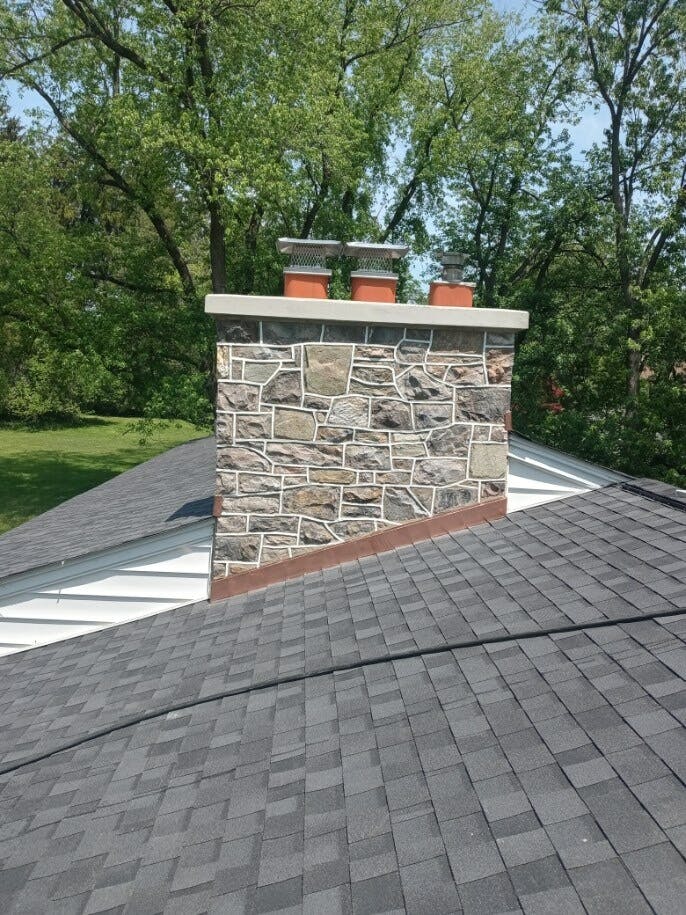Damaged chimneys should be repaired as soon as the damage is noticed to prevent it from spreading and causing hazardous conditions at your home.
If your chimney is left unrepaired, water may intrude into the walls of your home through the damage. This can lead to additional and severe damage to your home. Damaged chimneys can also present physical dangers, such as the risk of collapse. And, they can even lead to a variety of secondary hazards for those living within the home.
It’s those secondary hazards that we want to bring attention to with this article. Though, that doesn’t mean we’ll be ignoring the other dangers damaged chimneys pose.
Hazards Caused by Damaged Chimneys

The four main hazards caused by damaged chimneys are carbon monoxide, creosote, house fires, and smoke and soot. By keeping your chimney in good condition, you will reduce the risks of these potentially deadly hazards.
Carbon Monoxide
Carbon Monoxide is a colorless, odorless, and poisonous gas that’s produced by combustion. The symptoms of carbon monoxide poisoning include headaches, nausea, dizziness, fatigue, loss of consciousness, organ damage, and death.
Fireplaces are one common source of carbon monoxide in homes. Normally, the carbon monoxide produced by your fireplace travels up the chimney and out of your home. But, if your chimney is damaged, it could cause the carbon monoxide to flow into your home, either by going back down the chimney or by escaping through cracks.
Creosote
Creosote is an oil produced by burning wood. It dries on the interior lining of the chimney and can build up over time. This buildup of creosote is dangerous for multiple reasons.
First, it can lead to a blockage of the chimney flue, causing toxic fumes to become trapped within the home. Second, it’s combustible and can ignite when you least expect it. And third, it’s a skin and eye irritant, it’s dangerous if ingested, and long-term exposure to it can lead to cancers and mental issues.
House Fire
There are many causes of house fire, one of the most common home hazards. The two causes related to chimney damage are creosote buildup (and combustion) and the intrusion of hot gasses into other parts of the home which can ignite wooden parts of the home.
Smoke and Soot
Under normal circumstances, smoke and soot should flow up the chimney and out of the home. However, if the chimney is blocked or otherwise damaged, the smoke and soot may flow back down the chute and into the home. It may also make its way into other parts of the home through cracks in the chimney.
The primary dangers of smoke and soot are the medical problems that inhaling the substances can lead to. These include asthma, bronchitis, and lung cancer.
Common Chimney Damage

Chimneys can be damaged in many ways. Common types of chimney damage include blockages, cracks, damaged crowns, damaged liners, pests, spalling, and water damage.
Blockages
Blockages of the chimney flute can be caused by structural damage, animal nests, and creosote buildup. Chimney blockages are dangerous because they can force smoke, soot, and carbon monoxide back down the chimney and into your home.
Cracks
Over time, cracks may develop in various parts of your chimney due to normal wear and tear. Exterior cracks can allow moisture and pests to get inside. And interior cracks can release toxic fumes into other parts of your home. Additionally, cracks can compromise the structural integrity of the chimney, potentially leading to collapse.
Damaged Crowns
The crown (or cap) sits at the very top of the chimney and serves to prevent things from entering the chimney from the top. A damaged crown may allow rain and pests into your chimney cavity. Pieces of the crown may even lead to a blockage of the flue.
Damaged Liners
Liners are what contain the fumes within the flue of your chimney. If the liner becomes damaged, it can lead to increased wear on the masonry of the chimney, can allow toxic fumes to escape into the home, and can expose the internal structure of your home to hot gas.
Pests
Birds, bats, squirrels, rats, mice, and more all like making their homes within chimneys. Nobody wants these pests to get inside their homes. They can cause damage, spread disease, block the chimney with nests, and they stink when they die.
Spalling
Spalling is when the outer layers of brick masonry chip and flake off. It’s caused by the bricks being exposed to freeze-thaw cycles throughout the year. As the layers of brick flake off, the next layer is exposed to the elements. Eventually, this damage will harm the structural integrity of the chimney.
Water Damage
Surprisingly, water is one of the leading causes of damage to homes. It can lead to spalling due to freeze-thaw cycles. It can get into other parts of your home, such as walls, through your chimney. And once inside, it can lead to mold and mildew development. If wooden frames are exposed to moisture, they can also rot away.
Chimney Restoration Services

Damaged chimneys need to be restored as soon as possible to prevent hazards. The three main components of chimney restoration are crown and flashing repair, masonry repair, and chimney sweeping.
Repairing the crown, flashing, and masonry of your chimney is vital for preventing pests, water, and other exterior damage from getting into your chimney and causing further problems.
Chimney sweeping is necessary for clearing out blockages made from creosote buildup, pest nests, soot, and more. It’s recommended that chimney sweeping is performed annually and by a trained professional due to potential safety hazards, such as exposure to toxic substances.
Schedule a Chimney Inspection Today
Is your chimney showing signs of damage? Has it been years since you last used your fireplace? Are you concerned about potential blockages or cracks? Contact McNamara Masonry Chimney Restoration today to schedule an inspection of your chimney.
